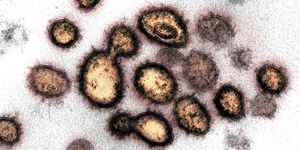How Deer Antlers Can Teach Us About Cancer Treatment
Deer, cows, and goats are part of a diverse group of mammalians called ruminants. A study of their evolutionary relationship and genetics that was performed last year and reported in Science has also revealed more about the unique headgear that grows on deer. This growth parallels that of cancer, so these findings may provide insight into cancer prevention and treatment.
Deer antlers are very unusual; they are the only organ found in mammals that regenerates. The cells that antlers are made of can proliferate rapidly, enabling antlers to grow really quickly. This kind of rapid growth is also seen in cancer. The speed of antler growth even outpaces that of cancerous tumors, the research found. In red deer, for example, antlers grow at a rate of about 1.7 centimeters per day. So why are deer able to grow antlers incredibly fast, but they don't get cancer in the process?
Gene expression in deer can help explain how this happens, and these insights may also can teach us more about cancer. In deer, a gene called FOS is very active. But this is also a known oncogene (in humans, it's called c-Fos) - and it's a gene that can cause cancer just by being overactive. It would typically be necessary for a multitude of changes to build up over time in different genes to cause cancer. That isn't even the only gene that can lead to cancer that is overexpressed in deer.
It seems that deer are able to keep cancer from developing because of other genes, one of which is called p53. This gene is known as a tumor suppressor and has been called the Guardian of the Genome because it checks the genome for damage (which can lead to cancer). If damage is found, the p53 protein calls in repair molecules. The p53 gene was first thought of as an oncogene because it is mutated so frequently in cancerous tumors; it turned out that if mutations prevent p53 from doing its critical job, cancer arises.
Deer have proteins that help p53 get its job done, as well as carrying other tumor-suppressing genes that are only expressed in the antlers. As they evolved, this allowed deer to keep their antlers, which were advantageous for social and mating reasons, while preventing them from developing into cancer.
Sources: Gerontology, Science








